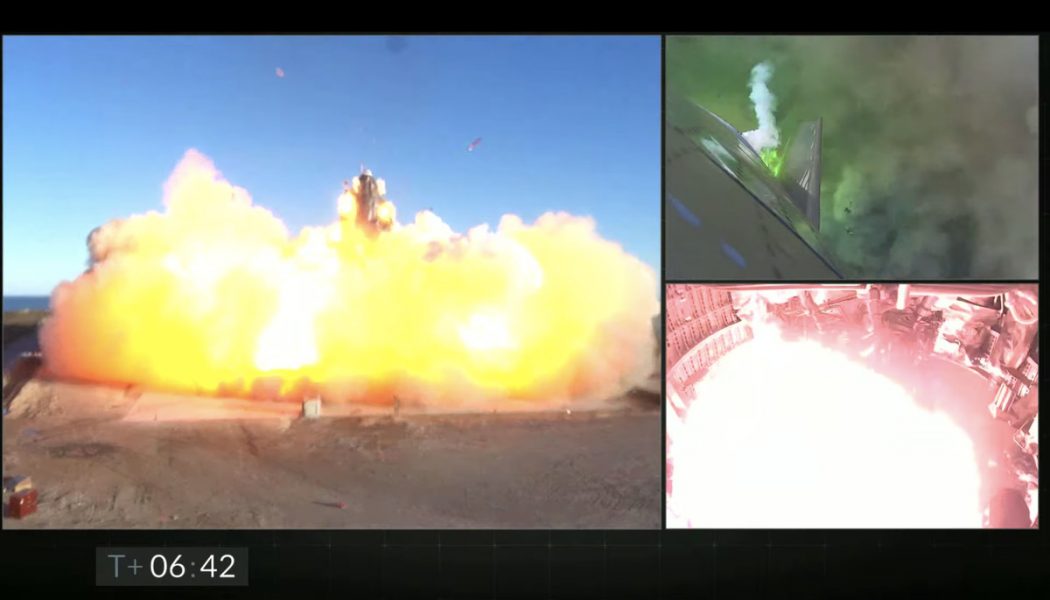During a test flight on Wednesday, SpaceX flew a prototype of its next generation Starship rocket to its highest height yet in the skies above Texas — but failed to stick the landing, with the vehicle exploding when it hit the ground. Propelled by three main engines, the vehicle launched to an altitude of nearly 8 miles, or 12.5 kilometers, before crash landing into the Earth.
The nearly seven-minute test flight took off at around 5:45PM ET from SpaceX’s facility at Boca Chica, Texas. The prototype climbed to its target altitude, but during the flight, two of its three main engines seemingly shut down while it ascended. Eventually all three engines cut off, and SpaceX attempted to perform a “bell flop” maneuver, with the vehicle falling horizontally on the way down to Earth. Just before reaching the ground, the prototype reignited its engines — but the vehicle came in way too fast and blew apart when it hit the ground.
The flight was the most ambitious test yet of SpaceX’s Starship, meant to test out the launch and landing capabilities of the future rocket. Made out of a steel alloy, the silo-shaped rocket is supposed to act as a spaceship, a rocket, and a lander all in one, carrying people and cargo to deep-space destinations. SpaceX plans to launch the vehicle to orbit on another massive rocket called the Super Heavy. Once in space, Starship is supposed to use its main engines to land upright on other worlds — such as the Moon or Mars.
Despite the explosive landing, SpaceX still considered the test a win. On its livestream of the event, the company included a banner that read: “Awesome test. Congrats Starship team!” SpaceX CEO Elon Musk also expressed enthusiasm for the flight on Twitter, noting that the test succeeded in a number of its objectives. Earlier, Musk only gave the flight a one-third chance of success, noting that a “lot of things need to go right.”
Even before the flight occurred, SpaceX had noted on its website that completing a perfect flight wasn’t the marker for success. “With a test such as this, success is not measured by completion of specific objectives but rather how much we can learn, which will inform and improve the probability of success in the future as SpaceX rapidly advances development of Starship,” the company wrote.
:no_upscale()/cdn.vox-cdn.com/uploads/chorus_asset/file/22158572/starship_10.png)
SpaceX has been cranking out Starship prototypes over the last few years at the company’s test facility in Boca Chica, performing incremental tests and flights on the vehicles in preparation for sending one to orbit. The one that flew today is the eighth major prototype the company has crafted. SpaceX has flown a few Starship prototypes before, but only to just under 500 feet, or 150 meters, in the air. Those prototypes were also smaller in size than the final Starship design, and didn’t sport the nosecone at the top of the vehicle.
Lot of things need to go right, so maybe 1/3 chance
— Elon Musk (@elonmusk) November 25, 2020
The prototype that flew today bore a much stronger resemblance to the finalized Starship, including the nosecone, as well as flaps on the side of the vehicle meant to help with steering during landing. The vehicle was also equipped with three Raptors, giant engines that SpaceX has developed just for Starship. The final Starship will supposedly be equipped with six main Raptor engines — three optimized to be used at sea level and three optimized for use in the vacuum of space.
:no_upscale()/cdn.vox-cdn.com/uploads/chorus_asset/file/22158548/starship2.png)
SpaceX already has two other prototypes built, similar in size and shape to today’s prototype — dubbed SN9 and SN10. It’s possible those vehicles will see some upcoming flights, as well, especially now that the eighth prototype is no longer in one piece.
SpaceX has a lot riding on these tests, as the company hopes to use Starship to fulfill Musk’s ambitions of starting a settlement on Mars. NASA is also considering using Starship as a lunar lander for its Artemis program. It’s possible NASA astronauts could take SpaceX’s Starship down to the surface of the Moon as a part of the agency’s Artemis program.
[embedded content]
Meanwhile, SpaceX has started construction on another important piece of the Starship system: the Super Heavy booster that will loft Starship into orbit. It’s unclear when the vehicle will take its first flight. In September of 2019, Musk predicted that SpaceX would send a Starship into orbit within six months. More than a year later, the timeline for the first orbital flight is murky — but today’s flight puts SpaceX closer to that important launch.









